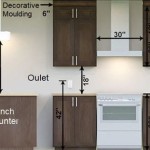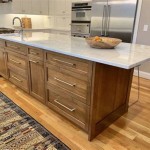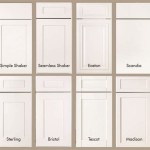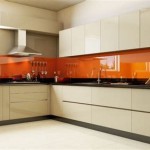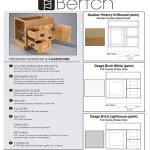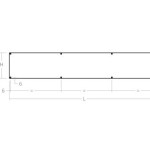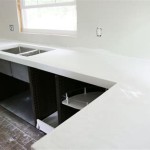Where To Install Knobs On Kitchen Cabinet Doors
The placement of knobs on kitchen cabinet doors is a seemingly small detail that significantly impacts the overall aesthetic and functionality of a kitchen. Proper knob placement ensures comfortable operation, enhances the visual appeal of the cabinetry, and contributes to the kitchen's overall design cohesiveness. Incorrect placement can lead to awkward handling, an unbalanced look, and even potential damage to the cabinet doors over time. This article will delve into the factors to consider when determining the optimal location for knobs on kitchen cabinet doors.
Understanding the Principles of Knob Placement
Several key principles guide the optimal placement of knobs on kitchen cabinet doors. These principles are rooted in both ergonomic considerations and visual harmony. Factors such as door size, style, and the intended function of the cabinet influence the ideal location for the hardware.
One primary consideration is ergonomics. The placement of the knob should allow for a comfortable and natural grip. This means positioning the knob in a location that is easy to reach and pull from without straining or contorting the wrist. The height of the user should also be considered; however, a standardized approach typically caters to the average adult height. While custom adjustments can be made for specific accessibility needs, the following guidelines generally provide a comfortable experience for most users.
Visual balance is equally important. The knob should be positioned to create a balanced and aesthetically pleasing appearance on the cabinet door. This often means centering the knob both vertically and horizontally within a designated area. However, deviations from perfect centering may be necessary to accommodate varying door styles and sizes. The goal is to create a visual harmony that integrates the hardware seamlessly with the cabinetry.
The style of the cabinet door also plays a significant role. Slab doors, for example, offer more flexibility in knob placement due to their simple, unadorned design. In contrast, doors with raised or recessed panels may require a more strategic placement to avoid obstructing the details or interfering with the panel design. Ultimately, the knob's position should complement and enhance the door's style, rather than detract from it.
Specific Placement Guidelines Based on Door Type
The recommended placement of knobs varies depending on the type of cabinet door. Standard base and wall cabinets generally follow consistent guidelines, while specialty cabinets may require more customized solutions. Understanding these variations is crucial for achieving a consistent and aesthetically pleasing look throughout the kitchen.
For standard base cabinet doors, a typical recommendation is to position the knob 2 to 4 inches from the top corner of the door on the side opposite the hinges. This placement provides a comfortable grip and aligns with the natural hand movement when opening the cabinet. Additionally, placing the knob near the top of the door reduces the leverage required to open a potentially heavy cabinet, especially those containing pots, pans, or other kitchen essentials.
Wall cabinet doors generally follow a similar principle, with the knob positioned 2 to 4 inches from the bottom corner of the door on the side opposite the hinges. This mirrored placement creates a consistent visual line between the upper and lower cabinets. The lower placement on wall cabinets also makes it easier to reach the knob, as wall cabinets are typically positioned higher than base cabinets.
Drawers typically have the knob centered on the drawer front. For smaller drawers (less than 12 inches wide), centering the knob both vertically and horizontally creates a balanced and symmetrical appearance. For wider drawers, a single centered knob may appear disproportionately small. In these cases, two knobs can be used, spaced equidistant from the center point and each other, creating a more balanced look.
Pantry cabinets, especially those with full-height doors, often require a slightly different approach. The knob is typically placed at a comfortable height (around 36 to 40 inches from the floor), allowing easy access for users of varying heights. Placing the knob at this height on a pantry door ensures comfortable operation without requiring excessive bending or reaching.
Finally, for specialty cabinets such as corner cabinets or appliance garages, the knob placement will depend on the specific design and functionality of the cabinet. The general principles of ergonomics and visual balance still apply, but the placement may need to be adjusted to accommodate the unique shape or opening mechanism of the cabinet. It's often helpful to visually mock up the placement before permanently installing the hardware to ensure it meets the functional and aesthetic requirements.
Practical Tips for Installation
Accurate marking and drilling are essential for a professional-looking installation. Taking the time to properly measure and mark the knob locations will prevent errors and ensure consistency across all cabinet doors. Using the right tools and techniques is equally important for achieving a clean and durable installation.
Before starting, gather the necessary tools and materials. This typically includes a measuring tape, pencil, drill, drill bits (sized appropriately for the knob screws), a screwdriver, and a level. A cabinet hardware jig is a valuable tool for ensuring consistent placement across multiple doors. These jigs provide pre-drilled holes or guides for marking the knob locations, significantly speeding up the installation process and reducing the risk of errors.
Begin by measuring and marking the desired location for each knob. Double-check the measurements to ensure accuracy. If using a cabinet hardware jig, align the jig with the edge of the door and mark the drilling location through the jig's guide. If not using a jig, use a level to ensure the marks are aligned horizontally or vertically as needed.
Once the locations are marked, use a drill to create pilot holes. Pilot holes are essential for preventing the wood from splitting and making it easier to insert the screws. Ensure the drill bit is the correct size for the knob screws. Drill straight and evenly, avoiding excessive pressure that could damage the cabinet door.
After drilling the pilot holes, insert the knob screws and tighten them securely. Avoid overtightening, as this could strip the screws or damage the cabinet door. Use a screwdriver to tighten the screws until the knob is firmly in place. Periodically check the knobs to ensure they remain tight and adjust them as necessary.
For cabinets with existing hardware, it may be necessary to patch the old holes before installing the new knobs. Use wood filler to fill the holes and sand the surface smooth. Once the filler is dry, paint or stain the patched area to match the cabinet door. This will create a seamless and professional-looking finish.
Finally, consider using backing plates or washers behind the knobs, especially on frequently used cabinets. These plates distribute the pressure from the screws and prevent the knobs from pulling through the cabinet door over time. This is particularly important for cabinets made from softer materials, such as particleboard or MDF.
By carefully considering these factors and following the recommended guidelines, a homeowner can achieve a professional-looking and functional installation that enhances the overall beauty and usability of their kitchen.

How To Place Cabinet Knobs Pulls

How To Install Knobs On Cabinet Doors

Learn How To Place Kitchen Cabinet Knobs And Pulls Cliqstudios

How To Install Knobs On Cabinet Doors

How To Install Knobs On Cabinet Doors

Learn How To Place Kitchen Cabinet Knobs And Pulls Cliqstudios

How To Easily Install Kitchen Cabinet Hardware The American Patriette

How To Place Cabinet Knobs Handles And Pulls

Cabinet Hardware Installation Guide At Cabinetknob Com

How To Install Cabinet Handles Ultimate Stress Free Tips

